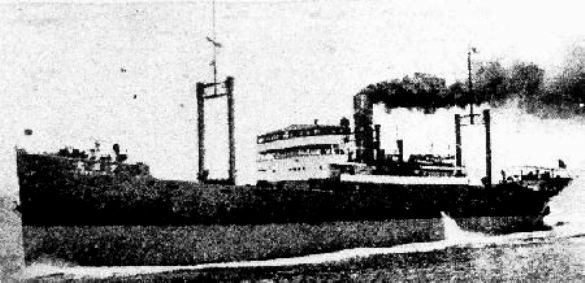KYUTANSEN!
 (YUBARI MARU, prewar)
(YUBARI MARU, prewar)
IJN YUBARI MARU:
Tabular Record of Movement
© 2016 Gilbert Casse, Berend van der Wal and Peter Cundall
18 October 1929:
Tama. Laid down by Mitsui Bussan Zosenbu K.K. shipyard for Kyoritsu Kisen K.K. as a 4,109-tons cargo ship.
1 April 1930:
Launched and named YUBARI MARU.
10 May 1930:
Completed and registered at Akashi.
20 May 1938:
Her owners and registered port are respectively changed to Hokkaido Tanko Kisen K.K. and to Tokyo.
15 August 1941:
Requisitioned by the IJN. Arrives at Kure.
5 September 1941:
Registered as an auxiliary collier attached to the Kure Naval District, (Otsu) category under instruction No. 1025. [1]
7 September 1941:
Departs Kure.
E September 1941 ~ January 1942:
Calls at Osaka ~ Hiro ~ Maizuru ~ Sasebo ~ Moji ~ Usa ~ Murozumi ~ Saitozaki ~ Chinkai, Chosen (now Jinhae, South Korea) ~ Dairen, Manchuria (now Dalian, northern China ~ Chinnampo, Chosen (now North Korea) ~ Kobe and Moji.
18 January 1942:
Arrives at Takao, Formosa (now Kaoshiung, Taiwan).
25 January 1942:
Departs Takao with KINSEN MARU.
1 February 1942:
Arrives at Davao, Mindanao, Philippines.
3 February 1942:
Departs Davao.
6 February 1942:
Arrives at Balikpapan, Borneo.
28 February 1942:
Departs Balikpapan escorted by auxiliary netlayer FUKUEI MARU No. 15 and auxiliary submarine chasers CHa-22 and TAKUNAN MARU No. 5.
1 March 1942:
Arrives at Macassar, Celebes (now Sulawesi). Departs there later that day.
5 March 1942:
Arrives at Bali. Attached to Southern Army Airforce supply units.
8 March 1942:
Departs Bali.
11 March 1942:
Arrives at Koepang, Timor.
27 March 1942:
During offloading in Koepang harbor sustains a Dutch airstrike. Sinks after receiving two direct hits in number one hold. One crewman is KIA. The crew of hospital ship ASAHI MARU helps rescueing survivors.
4 April 1942:
Removed from the Navy’s list under internal order No. 662.
Authors' Notes:
[1] There were two categories of Kyusuisen. (Ko) category with an IJN Captain as supervisor aboard and (Otsu) category without.
Thanks go to Gengoro S. Toda of Japan.
- Berend van der Wal, Gilbert Casse and Peter Cundall.
Back to the
Colliers Page





